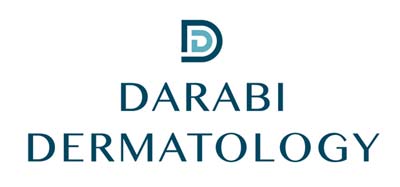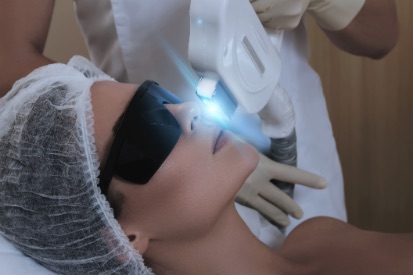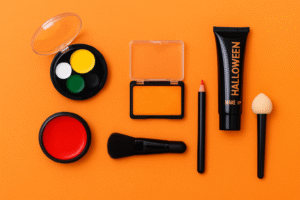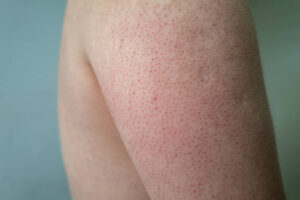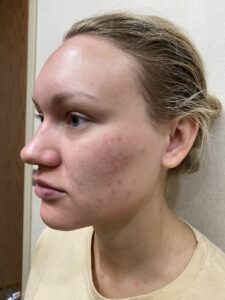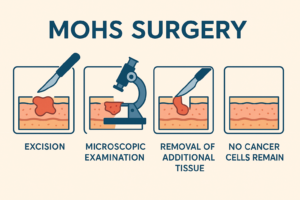Laser and light treatments have become key tools in dermatology. These technologies can help with common skin concerns like redness, brown spots, wrinkles, and even hair loss. Many treatments are quick and involve little to no recovery time.
This article breaks down several of the most popular types of lasers used in dermatology today, how they work, and what skin concerns they help treat.
DermaV® Laser
The DermaV® laser is used to treat visible blood vessels, redness, brown spots, and even unwanted hair. It works using two different types of laser light, which allows it to target both surface-level and deeper skin problems.
How It Works
This laser uses two wavelengths of light:
- One targets small, visible blood vessels and surface-level pigment (like freckles or sunspots).
- The other goes deeper into the skin to treat larger blood vessels and reduce unwanted hair.
This combination makes DermaV® very flexible and effective for treating multiple skin issues.
What It Helps With
- Broken blood vessels (on the face, chest, or legs)
- Redness from conditions like rosacea
- Brown spots (freckles, sunspots, age spots)
- Hair reduction on various parts of the body
Recovery Time
Most people experience mild redness or swelling that goes away quickly, usually within a day or two.
IPL (Intense Pulsed Light)
IPL stands for Intense Pulsed Light, and while it isn’t technically a laser, it works in a similar way. It’s one of the most commonly used light treatments in dermatology.
How It Works
IPL uses a wide range of light wavelengths that get absorbed by dark pigment (melanin) and redness in blood vessels. The light turns into heat, which breaks down the problem areas without damaging the surrounding skin.
What It Helps With
- Sun damage and age spots
- Facial redness and broken capillaries
- Uneven skin tone
- Signs of aging caused by sun exposure
Recovery Time
You may have mild redness, and dark spots might temporarily get darker before they fade. There’s usually no need to take time off work or regular activities.
Who Should Avoid It
IPL is safest for lighter skin tones. If you have a tan or darker skin, there’s a higher risk of uneven pigment changes.
CO₂ Laser Resurfacing (Deka Tetra SmartXide)
CO₂ lasers are used for more intensive skin resurfacing. They are considered the gold standard for treating wrinkles, scars, and rough skin texture. The Deka Tetra SmartXide laser is one of the most advanced versions available today.
How It Works
CO₂ lasers remove very thin layers of skin using a beam of light that targets water in the skin. This removes damaged skin and triggers the body to produce new collagen, which improves skin texture, tone, and firmness.
Fractional technology means that only small areas of skin are treated at a time, allowing for faster healing.
Types of Treatment
- CoolPeel®: A gentler version with very little downtime. Great for improving texture, pores, and light pigmentation.
- Moderate Resurfacing: A deeper treatment for wrinkles, more noticeable pigment, and skin laxity (looseness). Requires more recovery time but delivers more dramatic results.
- Acne Scar Treatment: CO₂ laser can also be used for acne scars, sometimes combined with a technique called subcision (releasing deep scar tissue under the skin).
What It Helps With
- Fine lines and wrinkles
- Uneven skin texture
- Large pores
- Acne scarring
- Sun damage and dark spots
- Loose eyelid skin
Recovery Time
- CoolPeel®: 1–4 days of mild redness and dryness
- Deeper resurfacing: Up to 7 days of redness, peeling, and swelling
LaseMD Ultra™
LaseMD Ultra™ is a gentle laser treatment used to improve skin texture, tone, and pigmentation. It’s a non-ablative fractional laser, which means it treats skin beneath the surface without removing the top layer — allowing for faster recovery.
How It Works
The laser creates tiny openings (microchannels) in the skin, which encourages collagen production and makes the skin more receptive to serums and active ingredients applied afterward.
What It Helps With
- Sunspots and melasma (a type of dark skin discoloration)
- Fine lines
- Large pores
- Dull, uneven skin tone
- Overall skin rejuvenation
Special Add-On: Tranexamic Acid
Right after the treatment, a serum with tranexamic acid can be applied. This ingredient helps lighten dark spots and prevent new ones from forming, especially useful for melasma or stubborn pigmentation.
Recovery Time
Most people experience mild redness for 1–2 days, with no significant peeling or downtime.
LaseMD Ultra™ with KeraFactor™ for Hair Loss
LaseMD Ultra™ is also used on the scalp as a non-invasive treatment for hair thinning and hair loss, especially in its early stages.
How It Works
The laser creates small channels in the scalp to allow KeraFactor™ serum (a blend of lab-made growth factors and proteins) to be absorbed more effectively. These ingredients support the health of hair follicles and encourage new growth.
What It Helps With
- Early-stage hair loss in both men and women
- Thinning hair
- Androgenetic alopecia (the most common type of hereditary hair loss)
Treatment Plan
- Usually 5 sessions spaced about 4 weeks apart
- Results are typically seen after 3–6 months
Comparison to PRP
Unlike PRP (Platelet-Rich Plasma), this method doesn’t involve drawing blood or injections. It’s painless, consistent, and has no downtime.
Quick Comparison of Treatments
| Treatment | Best For | Downtime | Good for Skin Types |
| DermaV® | Redness, brown spots, visible vessels, hair | Minimal | All skin types |
| IPL (M22™) | Sun damage, freckles, facial redness | None to mild | Best for lighter skin tones |
| CoolPeel® (Fractional CO₂) | Fine lines, light pigment, texture | 1–4 days | Light to medium skin tones |
| Moderate CO₂ Resurfacing | Deeper wrinkles, scarring, skin laxity | 5–7 days | Light to medium skin tones |
| LaseMD Ultra™ | Uneven tone, melasma, large pores | 1–2 days | Safe for all skin types |
| LaseMD + KeraFactor™ | Hair thinning and early hair loss | None | Men and women, all hair types |
Final Thoughts
Laser and light-based treatments are powerful tools in dermatology. They can be customized to suit a wide range of skin goals; whether that’s smoother skin, fewer brown spots, less redness, or fuller hair. These treatments continue to evolve, offering better results with less downtime than ever before.
That said, not every treatment is right for every person. Factors like your skin type, the condition being treated, and your availability for recovery time all matter. A qualified dermatologist can help guide you toward the safest and most effective option for your specific needs.
